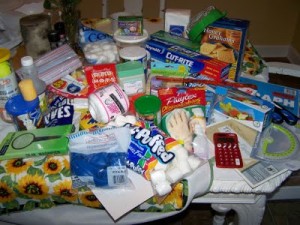 In past years, hands on history projects and science experiments often seemed to fall by the wayside. My kids love doing this stuff, and it is so valuable for them…but it just wasn’t getting done!
In past years, hands on history projects and science experiments often seemed to fall by the wayside. My kids love doing this stuff, and it is so valuable for them…but it just wasn’t getting done!
The main reason was the time involved in locating everything we needed to do an experiment. Frequently, after searching for an hour, we found that we didn’t have the necessary items on hand.
For the past few years I have been making science and history boxes over the summer. I am working on our history box right now.
I go through my curriculum for the year, looking at all the suggested hands on projects. I make a list on my computer of everything I need to do those projects. I put everything from Plaster of Paris to salt on my list. Once the list is complete, I gather all of these items, whether from the store or from my cupboards, and put them in the box labeled History Hands On. I will do the same process for Science Experiments.
I don’t want to interrupt my school day looking for a balloon, or find out that we can’t do a simple experiment because we ran out of vinegar. So I don’t leave even these common household items to chance. If we need them, they go into the box, even if it means having to buy an extra bottle of vinegar just for this purpose.
Of course next year, when putting my boxes together, I will cull leftover items from this year’s boxes first.
An added advantage to these boxes is that my kids can get the needed items together all by themselves. They don’t have to ransack the house looking for a spool of thread or a funnel. If their book says they need these items, they can be confident that they will find them in the box!
I take a similar approach to art supplies. Right before school starts I make sure that we have individual bins of markers, crayons and colored pencils ready to go. The kids check all markers and throw away any dry ones. They use an electric pencil sharpener and sharpen all colored pencils. Broken crayons are tossed in the garbage.
A small, plastic 3-drawer cart is stocked with computer paper, cardstock, primary writing paper, origami paper squares, page protectors and the like. One drawer holds stamps and ink pads, stickers, child scissors, glue sticks and other craft supplies.

Great idea! Thanks for sharing.
How do you choose which History crafts/projects to do with your family? Do you use the suggested TOG books or something else?
I’ve got to get organized in that area as we start back on ‘school’ in July when it gets hot in Texas.
Blessings. I enjoy your TOG info immensely!
Laura
Hi Laura,
I usually choose projects which seem fun and educational…things that appeal to me, since I am the one who has to implement it, LOL!
I am not very crafty or handy, so I steer clear of things like that. I also steer clear of anything that feels remotely like busy work.
Sometimes I let the boys choose between certain activities. I do not typically get the TOG activity books, such as Old Testament Days, because we don’t do enough hands-on things to justify it. I choose my hands-on projects from the list right in the TOG curriculum.
We implemented this idea just recently but all in one box. I love the idea of separate boxes as it will keep the kids from making such a huge mess in the storage closet. The space is small and no one wants to go in there, including me.
Darla